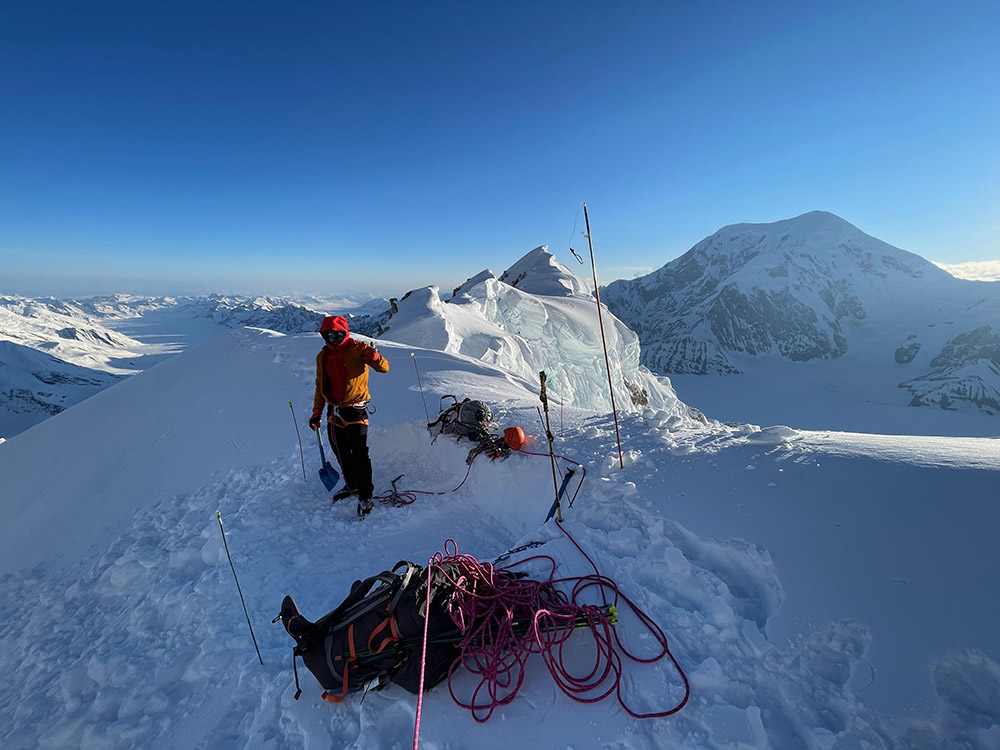Notes from an Alaska climbing trip
Peter McCarthy and I flew into the Alaska Range on May 22, 2022. Both of us felt nervous, me because it was my first time, Peter because it wasn’t his first time. TAT pilot Paul Roderick brought us as close as he could to our main objective, the West Ridge of Begguya (Mount Hunter), turning his Turbo Otter steeply back and forth. I felt I could’ve touched the ridge had I stuck my hand out the window.
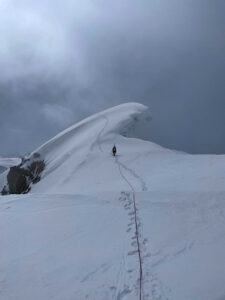
The mountains had experienced unheard-of high pressure the week preceding our trip. Watching others tick of a bunch of mega lines on social media had given us both FOMO and beta, as well as the sense that we were just missing the perfect window. Conditions were still stellar when we landed on the Kahiltna airstrip. Had we been more dialed we could’ve launched for the West Ridge that same night. Instead, we faffed about quite a bit, revamping a camp that a guided group had just left behind.
Uphill Athlete coach John Frieh had kindly agreed to text weather updates to my inReach as often as possible. Based on that, and after pushing back our launch twice, we settled on a good two-and-a-half-day window—realistically the least amount of time it would take us to climb to the top, not counting the descent—starting the morning of May 27.
In the intervening days, we climbed “the Knob,” aka the Radio Tower, which rises about 1,300 feet above Denali Basecamp, and Bacon and Eggs on the Mini-Mini-Moonflower, a sub-buttress to the sub-buttress of Hunter’s North Buttress. Our primary concern going into the latter was the ski up and then back down the Southeast Fork of the Kahiltna. The horror story of a Japanese climber who’d been swallowed by that same glacier the week prior was going around camp. But it ended up being a good day, giving me my first taste of technical Alaska climbing. My stoke to finally get on something cool in the range—I’d been looking forward to this for so long—was super high.
The Climb: Day 1
On Friday, May 27, we got up at midnight and skied down the Kahiltna to the base of Hunter’s West Ridge. I took the lead up the initial slopes, setting a brisk pace to minimize our exposure to the looming seracs above. Two hours in, we had nearly reached the Cat’s Ears—two rock towers crowning the first of many high points along the ridge. We wasted no time setting up a rappel that would reach all the way to the notch on the other side. Mistake number one. Instead of enjoying a smooth abseil, we wasted two hours unf**king our ropes, which got stuck in the highly featured terrain. Clearly we should’ve broken up the rap at an interim station.
Our goal for the day was to reach a great bivy ledge that Peter knew of from his previous attempt on the route. But first we would have to negotiate the ice and snow slopes leading up from the notch, then slog up a long snow bump, and then tackle a rock band, allegedly the technical crux of the climb. We reached the top of the snow bump around 3 p.m., and both of us estimated that another five hours of climbing would get us up the rock band and to our destination for the night.
The climbing through the rock band wasn’t exactly straightforward, but the most challenging aspect of it proved to be moving with our large, unwieldy packs, our wands protruding a foot and a half above our heads. After hours of grunting and groveling and getting stuck on those hellish wands and old fixed lines, we made our way up most of the band, with Pete doing the majority of the leading. Then I got to lead a short but fun bouldery pitch, which took us to the actual crux: the Beckey Chimney. It looked like a nightmarish option with packs and wands, so we opted for an alternative that Peter knew of and dispatched quite diligently.
Finally, a scramble up snow brought us to the flat bivy spot next to a large, sheltering rock around 11 p.m.; 8 p.m.—“weather o’clock,” when the Denali Basecamp manager switches on their FRS radio and gives everyone a brief forecast—had long come and gone. But our campsite was super sweet and very comfy, and the views were the best I had ever earned in the mountains. So we enjoyed ourselves for a while, brewing and chatting and eating and drinking till we finally crawled into the tent and passed out.

Day 2
On purpose, we woke up late the next morning, having decided a seven-hour rest was necessary after 21 hours on the move the day before. Greeted with more stellar weather, we lingered at our bivy in the warm sun while eating breakfast and drying our down bags.
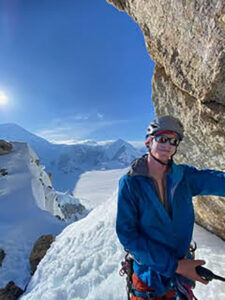
Around noon we got going. Two big, corniced bumps, one more intimidating than the other, had to be climbed to gain the knife-edge ridge leading to the summit plateau. We negotiated steep snow up to the first bump and the beginning of the day’s balancing act. It was essential to avoid getting too low on the steepening slope to our right, but staying too high would have put us directly on the edge of a crack running alongside the entire ridge crest, dividing the loose, corniced north side from the steep, hard-packed south side. The trick was to quickly determine the threshold between the pow-cornice and the steep, icy terrain to the right while maintaining forward momentum.
Between the two cornice bumps, the ridge narrowed considerably, and though the terrain was fairly flat on top, a slip would have meant a slip off of the entire mountain. We kept some running pro most of the time. The grade steepened and a couple of more interesting rock, snow, and ice pitches brought us up a larger crest, where a steep, rising snow traverse took us back to the real ridge. At that point the crest flattened, and we hoped to get a respite from all the heads-up movement. Not so. A crevasse was lurking under the wind-deposited top layer of snow, and more than once I “probed” into the crack with my entire front leg but managed to breaststroke myself sideways to stay clear of plunging in.
Eventually we made it to a notch immediately below the knife-edge ridge. Although the steep slope to the ridge wasn’t as iced up as it might usually be in late May, climbing it and the knife-edge wasn’t attractive to us that evening. It was 10 p.m. and we decided to bivy in the notch and launch for the top the following morning. By this point we had passed Peter’s previous high point on the route, and we’d both started to feel increasingly sure that we’d tag the summit the following day. Warmed by this confidence, as well as the effort it took to establish a secure platform, we turned in.
Day 3
The following morning we woke to weather conditions that had deteriorated completely. It was not too cold, nor was there much precipitation, but the visibility was almost zero up the mountain. At times we could make out the first of two rock ribbons on the face that we’d studied the previous night. Yet for most of that morning all we saw looking upward was milky fog. Navigating up to and across the knife-edge in whiteout conditions felt intimidating, if not stupid.
I experienced a rising angst as I saw our chances for a summit bid that morning disappear into the thick clouds. Pete was able to address things soberly and suggested that we wait and see if conditions would progress in our favor. We agreed to give it till early afternoon before making another call. Frustratingly, nothing changed.
Nixing the bold and foolish move of charging up into the mist, we were left weighing two options: to remain where we were till the fog eased or to go back down. Pete was more in favor of rationing our dwindling supply of food to stretch the time we could spend on the ridge than I was. In retrospect, I wish I had agreed to that plan.
If we had stayed and starved a bit more, could we have reached the summit? That what-if thinking continues to nag at me. The hardest thing in alpine climbing, really, is neither the technical nor physical obstacles but rather your ability to determine where that fine line is that you cannot reverse from. And the only way to develop that decision-making ability is to climb more mountains—to take risks time and again in order to be better able to mitigate those risks.

At that point we were on our last real day’s worth of food. We had packed a total of three and a half days of rations, estimating that it would take us about four and a half days from basecamp to the top and back to basecamp. The margins were not great. A couple of pieces of hardware and hell-wands less, and a couple of dinners more, would’ve possibly tipped the scales more in our favor. In hindsight I think we most likely could have survived a little more starvation. But our descent probably would have been even slower, and the suffering that much greater.
Somehow my vote to go down won out over Pete’s to stay on. Down we went. (Addressing this chain of decisions with Pete later, I learned that he did not blame me at all for pulling the plug. He said he was happy, in a sense, that we’d chosen to retreat given how tenuous the descent felt.)
Right after the knife-edge, the Ramen Couloir meets the West Ridge, providing an alternate ascent/descent option. A faint track from the middle of the knife-edge into the upper couloir suggested that maybe Clint Helander and August Franzen, who’d FA’ed the West Buttress on Hunter the previous week, had descended that way. But the rumbling sounds of continuous slides, mainly from the Ramen Valley to the south of us, made us less and less inclined to opt for the Ramen—or for any other couloir for that matter.
Instead, we retraced our steps. It was less mentally taxing, as we knew what the terrain had to offer. But since the ridge is shaped more like a roller-coaster ride than a continuous slope, it felt like there was as much climbing involved in going down as there was in going up. Yet the confidence of knowing the treacherous sections allowed us to protect less and move fast. We got into an efficient flow on the steep snow and moderate rock and ice, stopping only to swing simul leads.
At our first bivy site, we took a break to savor the glorious salami that we’d saved for a weak moment. One of the nice things about climbing with Pete is that we have quite a bit of patience for each other. He is an easy dude to be with in remote places: he’s not a rookie, and he has a good personality. Resting and refueling gave us the spark to rap/downclimb the rock band, which we estimated would go faster than climbing it.
Due to faff, fatigue, and some sketchy traversing pitches, it ended up taking a sweet while. Once we got to the notch below it was 2 a.m. and we were in a half-zombie state. Turning the last corner of rock in the lower section of the band, Pete, who was ahead of me, noticed another tent pitched in the very notch we were aiming for. It was the exact same model of ultralight alpine tent we were using. Reality tipped and inverted. It was almost as if we were experiencing ourselves going the other way on the ridge in a parallel time line to the one we were currently in.
We dug ourselves a little trench some 50 yards away from our doppelgängers, had a very late but quite rewarding final dinner, and turned in.
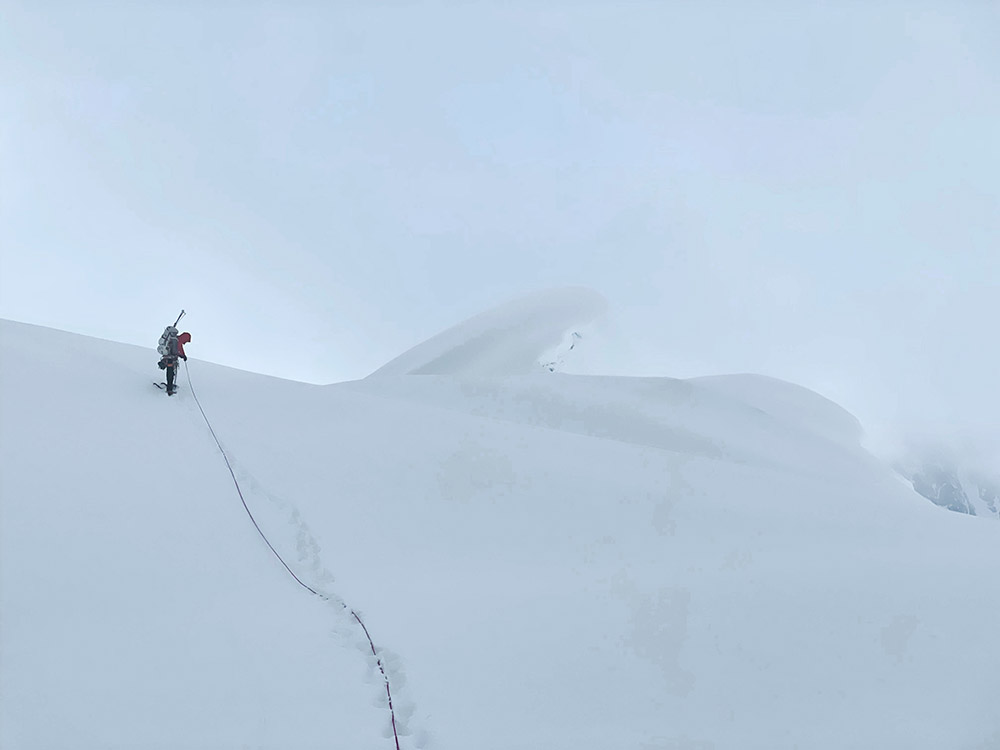
Day 4
“Bah! Bah! Bah!” I slowly, groggily regained consciousness to something just as trippy as the sight of the identical tent the night before. Strange, guttural outbursts were coming from outside our tent—sounds that seemed to fit better with my foggy dream reality than with what was actually happening in our physical proximity.
“Pete, you hear that too, right?” Pete confirmed he did. Along with the male voice—the source of the repeated animalistic grunt—we could also make out a female voice. The other party camped nearby was clearly pressing along, their pickets and other hardware clanking. Pete suggested that maybe the male climber had Tourette’s*. Whatever the case, our alternate-reality duo was making a bid for the summit.
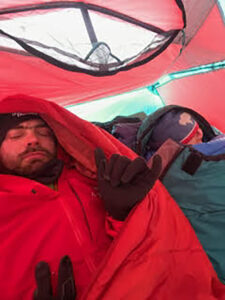
We’d slept uncomfortably, both of us experiencing almost identical symptoms of pain, tingling, and numbness in our arms, hands, and fingers. Initially we chalked it up to the effect of sleeping like sardines in a tin, because it obviously wasn’t frostbite or frostnip. Now I think it was likely muscular overuse from gripping our ice tools in a cramp-like way for days. (As I write this, almost a month later, the numbness in some of my fingertips is still there.)
By the time we emerged from our tent to brew oatmeal and hot drinks, the other party had climbed out of view. To our frustration and dismay, the weather up the mountain had turned clear, sunny, and calm again! Had we still been at high camp it would’ve been a splendid day to summit. The one thing that cheered us up was the fact that we had only so much distance to retrace to get back to basecamp and our duffel bags full of food. Yet the stoke wasn’t high and we weren’t fighting for our lives to descend. Getting our asses down seemed straightforward at this point, just not too fun.
Back up to and through the Cat’s Ears we went, pitching out the rock section under the Ears where our ropes had gotten stuck. It was some of the better climbing on the entire ridge. But by then it was late in the afternoon and the snow had turned slushy. We waited in a flat area near the Ears for the snow to get cold enough for us to trust it over the cracks in the icefall down to the Kahiltna Glacier. Our moods were more elevated than they had been all day. We took off our boots, drank, ate, and chatted about upcoming summer climbing plans, which put things into perspective and made the loss of Hunter’s summit sting a bit less.
Once it was too cold to sit still any longer, we started down toward the Kahiltna, Pete in front, me in the back with the second rope in my pack. The snow was still quite soft, which kept us on edge and observant. We progressed attentively through the mashed potatoes, at one point stopping again to let it chill more until we got too chilled ourselves.
Deeply tired at this point, I did not feel terribly scared, just acutely aware of the hazards around us. There were obvious chasms to the left and right of our direction of travel. The cracks ran perpendicular across the glacier. Pete had to commit to a snow bridge in this section. Giving him some rope, I braced for impact. He sank to his waist but was arrested by his own hips on the edges of the hole, which was now obvious enough for me to leap across.
Following that we had no more drama, and soon we arrived at our skis at the bottom of the hill. As we came into basecamp at 2 a.m., slogging the last hundred yards to our tent, several West Buttress teams that were getting ready to head to Camp 1 cheered us on. We didn’t speak much; the fatigue was total. After managing to brew some couscous with sausage crumble, cheese, and butter, we ate an entire chocolate cake. It felt alright to be back, largely alive and uninjured. We fell into a deep sleep, the lingering questions about that fine line between pushing just enough and pushing too far momentarily forgotten.
*Back in Talkeetna days later, Butchy Fuego, an employee of TAT who had assisted this other party upon departure, confirmed that the male half of the team had Tourette’s.

